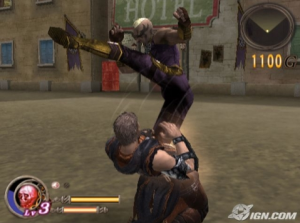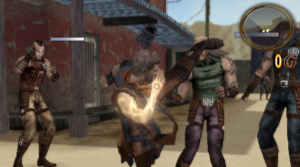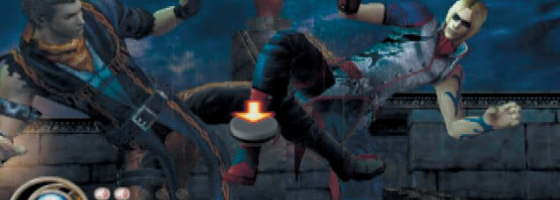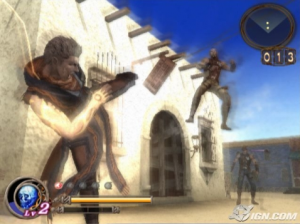Playing through Bayonetta 2 last year, while it was a good game it doesn’t come anywhere close to taking the place of what I consider to be the best action games. I’ve written extensively about the action genre and these games before but I’m in the mood to talk more about what they did right from a mechanic standpoint starting with my #3 — God hand.
Dragon Kick:
Godhand was developed by Clover Studios and was their final game released from the studio. It is also famously known as the game that IGN completely screwed up on with reviewing it, citing it as a horrible broken game when in fact it was one of the best action games released that year.
Godhand was designed with a completely different mindset compared to other action games and featured both rogue-like and RPG elements to the gameplay. First was how the difficulty of the game flucutrated based on player skill. In the bottom left corner of the screen you would see your difficulty standing from level 1 to level Die( or 4). Beat enemies without getting hurt and your rating would go up, die or get hit and it would drop.
What happened was not only did the enemies become smarter as the level went up, but the enemy encounters would be altered as well. One fight on level 3 would be with just two thugs could become 5 at level die.
And these enemies weren’t your basic scrubs, each one could attack, counter and punish your mistakes during combat. There was also the random chance of fighting demons: Elite enemies who took a lot of damage and would reward you with treasure chests.
The reason that you want to fight higher enemies comes from the RPG progression system of buying upgrades and how things got easier over time because of it.
Pumping Up:
God Hand was one of those games like Demon’s Souls where the beginning was harder than the end due to the lack of upgrades and player skill. As you played through God Hand you could go to a shop after each level to buy upgrades and new moves. Upgrades came in the form of more health, more special meter and the as mentioned moves.
How it was worked was that you would assign what attacks you wanted to use during combat to each of the button inputs plus special ones like back-X. Every move in the game had different attack damage, speed, range and special features like nullifing blocking enemies. The beauty of the system was that you had complete freedom to create your own fighting style in a sense — Do you go for quick moves that don’t do much? Stronger attacks that hit a lot of enemies but leave you open?

Dodging attacks was a lot more involved compared to other action games, but none of it was explained to the player
But all of this cost money and bringing this back to the difficulty system is where things get interesting. You were awarded money based on the difficulty level you were at when you killed every enemy.
So killing enemies at level 3 would give you less money than at level die and this is why the beginning of the game was so hard.
Besides your regular moves, you had two forms of trump cards in the form of the Godhand and the roulette attack. The Godhand would become activated as the bar fills in the bottom left; once activated it will give you a few seconds of enhanced damage invincibility.
The roulette attacks were special over the top moves that drained roulette orbs and would cause a lot of damage; either directed at one enemy or multiple.
Starting out you won’t be able to fight the enemies at the high levels to get the money for all the upgrades and you will have to learn how to make do before getting rewarded with new stuff. This sounds very similar to the Souls series which also made you work for your upgrades.
Unfortunately despite my love of God Hand, it did have some issues which led to the game being a commercial failure.
Ballbuster:
God Hand did not do a good job of explaining some of the finer points of combat and left it in the manual. For instance, you had several counter moves available after dodging attacks that were not mentioned in the game which is a big deal when you are fighting multiple enemies. Here’s a big example, I’ve beaten the game on normal and under the no special attack rule, but it wasn’t until 2015 that I learned from watching a YouTube video that the up-dodge move actually negated all damage except for vertical or straight attacks. Further still, you want to combine the up dodge move with the triangle button in order to perform a counter attack; none of which is mentioned anywhere in the manual
When you’re building a never before seen system, you need to explain the rules to the player and can’t leave things up to chance. Imagine playing a strategy game where the game doesn’t tell you what your units do or even how development works. That could be the greatest game ever made, but no one would want to fight their way through to learn its mysteries. With the ability to assign moves, I really wish they included an actual animation time frame instead of trying to watch each move to figure out what was quicker.
Getting back to fighting multiple enemies, God Hand’s behind the shoulder camera made multi fights incredibility difficult as you could not see the other enemies and were easily surrounded. As you can probably tell, God Hand is a game where if you get caught unaware you will most likely die and the camera was a root cause. The difference between one on one fighting and multi fighting were night and day and you had no real counter measures to attacks from off screen. The mini map didn’t do a good job as it just shows position but not incoming attacks.

Fighting multiple enemies was the hardest part of the game, due to your limited options and camera viewpoint.
I also think people didn’t like the difficulty system as having the game change in mid level like that made it hard to get accustomed to the game.
This is where Demon’s Souls was smart in how the world tendency changes only took affect after you left the level and the differences weren’t as pronounced compared to God Hand’s encounter changes.
But despite that, God Hand is my number three favorite action genre thanks to its in depth combat system. In fact the first action game that I wrote a design doc for featured a modified version of the system from God Hand and how you could assign attacks to the player.
Up next I turn to #2 which led the way for Bayonetta’s combat system but still remains one of the best.


